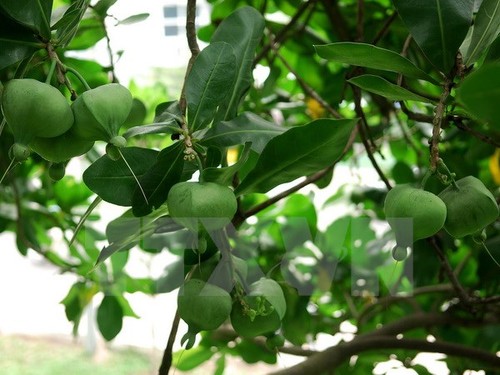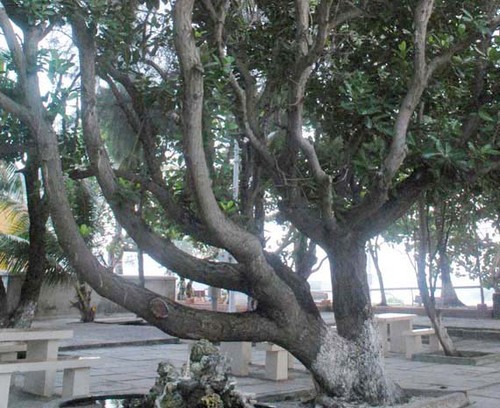(VOVworld) – Four of the 72 perennial trees recognized as Vietnam Heritage Trees last year are in Truong Sa island district in Khanh Hoa province. They are two Mu u or Calophylum trees on Son Ca and Sinh Ton islands, one Bang vuong or square-fruit Malabar Almond on Nam Yet island, and one Phong ba birch tree. All of them have special value in terms of history, culture, biology, and environment.
Despite wind and waves, Truong Sa island district has many kinds of trees adapted to the harsh weather and growing conditions on coral reefs. Among the trees grown there, the Phong ba birch tree is planted around the island to withstand strong winds and waves and provide shade for island soldiers resting between training hours.
 |
| Bang vuong or square-fruit Malabar Almond (Photo: Manh Linh/VNA) |
In the center of Song Tu Tay Island is a Phong ba birch tree, whose diameter equals two people’s arm spans. The tree has a lumpy trunk and white silver leaves. It’s the oldest tree in the Truong Sa archipelago, and a fitting symbol of Vietnam’s sovereignty over one of the nation’s most vulnerable regions.
Lieutenant-colonel Mai Van Thuyet, who is stationed in Song Tu Tay, says:
“Recognized as a Vietnam Heritage, the tree is clear evidence of Vietnam’s sovereignty, having been maintained by our predecessors for so long. The birch tree represents our sovereignty and our determination to protect Vietnam’s sacred land and encourage soldiers and other local residents of the island to follow national tradition.”
 |
| Mu u or Calophylum trees on Son Ca (Photo: VACNE) |
Son Ca island is famous for Mu u or Calophylum trees, which are typical of Vietnam’s southwestern region. Several Calophylum trees here are more than 30 years old.
Nam Yet Island is known for a century-old Bang vuong or square-fruit Malabar Almond tree with 8 trunks growing out of the tree root and roots rising out of the ground a hundred meters from the tree. Senior lieutenant Hoang Van Thuc, a soldier on Nam Yet island, says soldiers and military staff like to cod off in the shade of the almond tree after training or playing sports.
Thuc adds: “the most impressive thing for a young officer like me was seeing rows of green trees when I first set foot on the island. I was so impressed by stories about the island and its century-old trees which stand firm day after day against wind, waves, and storms to protect the island.”
Truong Sa is developing steadily. The flexibility and vigor of the trees on the archipelago symbolizes the resilient spirit of the Vietnamese people and the soldiers defending the national territorial waters.